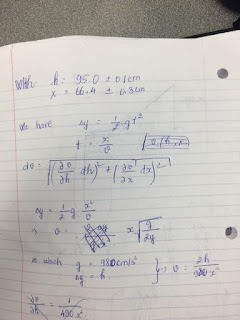Lab #5: Trajectories
Dahlia - Ariel - Carlos
14-Sept-2016
The purpose of the lab#5 is to help students know how to calculate the initial velocity based on the distance of a steel ball go. Moreover, this lab also help students predict the impact point of the ball on an inclined board.
Materials: Aluminum "v-channel", steel ball, board, ring stand, clamp, paper, and carbon paper.
Part A:
1. Set up:
we set up like this picture.
Then, we let the steel ball began to roll at the top of the aluminum "v-channel". This steel ball fell on the carbon paper. Thus, with the height of the table h, and the distance between the table and the carbon paper x, we needed to calculate the initial velocity of the steel ball.
we did this progress in 5 trials. this was the data we recorded after 5 times.
2. Analyzed data:
With the collected data, we calculated the value of distance x with uncertainty value:
thus, x=66.4± 0.3 cm
and the height of the table h = 90.0± 0.1 cm
so, we had:
Now, the initial velocity was 150.7 ± 0.7 cm/s
Part B:
Materials: Aluminum "v-channel", steel ball, board, ring stand, clamp, paper, and carbon paper.
Part A:
1. Set up:
Then, we let the steel ball began to roll at the top of the aluminum "v-channel". This steel ball fell on the carbon paper. Thus, with the height of the table h, and the distance between the table and the carbon paper x, we needed to calculate the initial velocity of the steel ball.
we did this progress in 5 trials. this was the data we recorded after 5 times.
2. Analyzed data:
With the collected data, we calculated the value of distance x with uncertainty value:
thus, x=66.4± 0.3 cm
and the height of the table h = 90.0± 0.1 cm
so, we had:
Now, the initial velocity was 150.7 ± 0.7 cm/s
Part B:
Now, from part A,we know that the initial velocity was 150.7 ± 0.7 cm/s
with the known angle, we had to calculated distance d (as shown)
This were how we solved the problem.
Thus,we measured that distance d would be 79.6 cm.
then, we did an experience to check my work.
we measured the angle, and it was 48.6 degrees.
Then we let the steel ball move.
and we collected the result.
in 5 trials, our record was this.
This was not too bad. With the theoretical value for d was 79.6 cm, and the experimental values was shown, I could conclude that if I know the initial velocity and value of an angle, I could calculate the distance of the steel ball move along the slope.













No comments:
Post a Comment